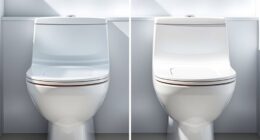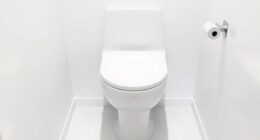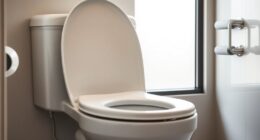We know how frustrating it can be when the toilet won’t flush, and frozen pipes could be the culprit. In this article, we’ll show you how to determine if your toilet pipes are frozen and what steps you can take to thaw them out.
By understanding the common symptoms and physical signs, you’ll be able to tackle this issue with confidence.
So let’s dive in and master the art of identifying frozen toilet pipes!
Key Takeaways
- Water not flowing out when flushing the toilet is a common symptom of frozen toilet pipes.
- Physical signs of frozen toilet pipes include lack of water flow, frost or ice buildup on exposed pipes, and strange noises like gurgling or rattling.
- Strange noises such as gurgling, whistling, and rattling, as well as strange odors like sewage smell, musty smell, and rotten egg smell, can indicate various issues with toilet pipes.
- Water flow issues in the toilet can be caused by toilet bowl leakage or clogged drains, and it is important to address these issues promptly to prevent further damage.
Common Symptoms of Frozen Toilet Pipes
One common symptom of frozen toilet pipes is water not flowing out when we flush the toilet. When the pipes freeze, the water inside them becomes solid, blocking the flow and preventing the toilet from functioning properly.

There are several potential causes of frozen toilet pipes, including extremely cold temperatures, lack of insulation, and improper installation of pipes.
To prevent frozen toilet pipes, it’s important to take certain precautions. Insulating the pipes with foam or pipe sleeves can help retain heat and prevent freezing. It’s also important to keep the temperature in the bathroom above freezing by using a space heater or opening cabinet doors to allow warm air to circulate around the pipes. Regularly checking for any leaks or cracks in the pipes can also help identify potential issues before they lead to frozen pipes.
In the next section, we’ll discuss the physical signs of frozen toilet pipes and how to address them.
Physical Signs of Frozen Toilet Pipes
To determine if toilet pipes are frozen, we need to look for specific physical signs. These warning signs can help us identify the problem early and take necessary action. Here are three physical signs of frozen toilet pipes:
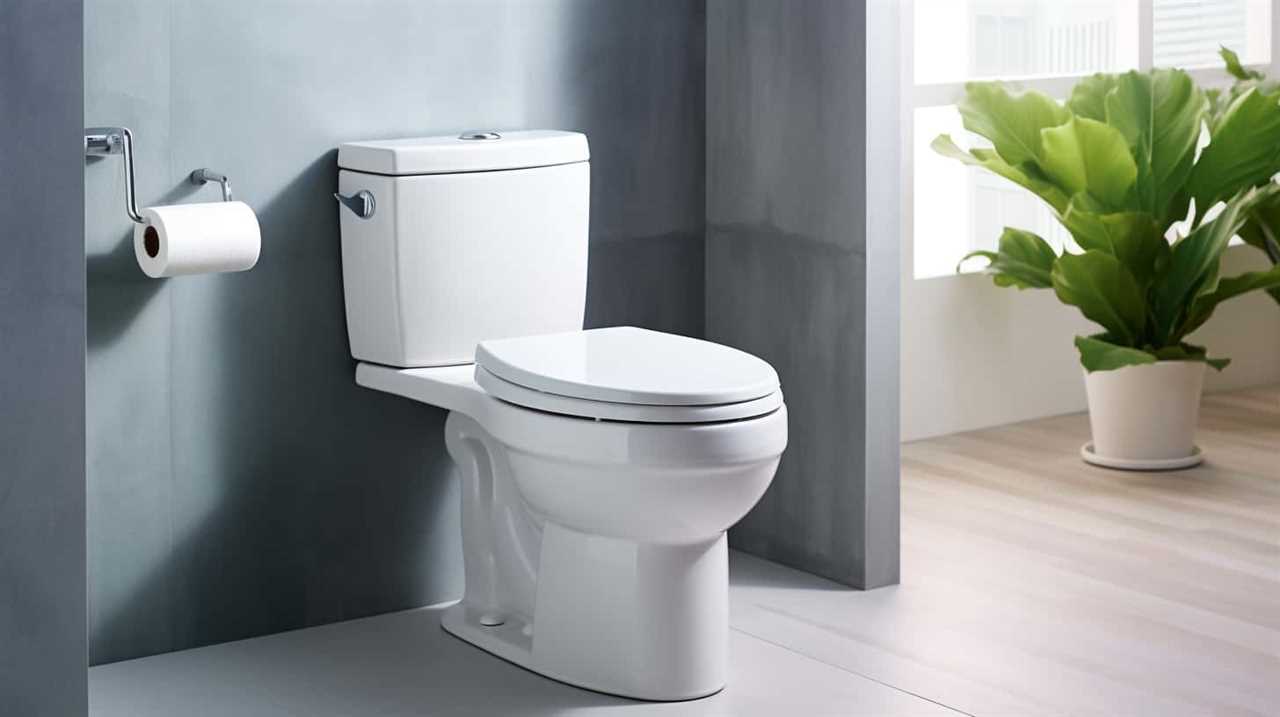
- Lack of water flow: If you notice a significant decrease in water flow or no water at all when you flush the toilet, it could be a sign of frozen pipes. Frozen water can block the pipes, preventing the water from flowing properly.
- Frost on the pipes: Check the exposed pipes in your bathroom, especially near the toilet. If you see frost or ice buildup on the pipes, it indicates that they’re frozen.
- Strange noises: Frozen pipes can make strange noises when water tries to flow through them. Listen for gurgling or rattling sounds when you flush the toilet.
Prevention methods such as insulating the pipes and keeping the bathroom warm can help avoid frozen toilet pipes. Regular maintenance and monitoring can also help identify and fix the issue before it becomes a major problem.
Strange Noises and Odors From Toilet Pipes
What causes strange noises and odors to come from our toilet pipes? When it comes to toilet pipe maintenance, it’s important to be aware of any unusual sounds or smells. These can be indicators of underlying issues that require troubleshooting. To help you understand the possible causes, refer to the table below:
| Strange Noises | Possible Causes | Recommended Action |
|---|---|---|
| Gurgling | Partial clog | Use a plunger to clear the blockage |
| Whistling | Faulty fill valve or flapper | Replace the faulty component |
| Rattling | Loose pipes or valve | Tighten or secure the affected parts |
| Strange Odors | Possible Causes | Recommended Action |
|---|---|---|
| Sewage smell | Damaged wax ring or sewer line | Inspect and replace the damaged component |
| Musty smell | Mold or mildew growth | Clean and disinfect the affected area |
| Rotten egg smell | Bacterial growth in the drain | Flush the drain with a mixture of vinegar and water |
Water Flow Issues in the Toilet
We experienced water flow issues in our toilet that were likely caused by the strange noises and odors coming from the toilet pipes. These issues can be indicative of toilet bowl leakage or clogged drains. When faced with water flow problems in the toilet, it’s important to address them promptly to prevent further damage.
Here are some common causes of water flow issues in the toilet:

- Toilet bowl leakage, which can occur due to cracks or faulty seals.
- Clogged drains, caused by the accumulation of debris or foreign objects.
These issues can lead to reduced water flow or even complete blockage in the toilet, resulting in inconvenience and potential water damage. To resolve these problems, it’s essential to follow the steps to thaw frozen toilet pipes, which will be discussed in the subsequent section.
Steps to Thaw Frozen Toilet Pipes
To thaw frozen toilet pipes, we need to follow a few simple steps.
First, locate the frozen section of the pipe by feeling for cold spots or listening for a lack of water flow. Once identified, turn off the water supply to the toilet.
Next, apply heat to the frozen area using a hairdryer, heat lamp, or heating pad. Be cautious not to overheat or use an open flame, as this may damage the pipes.
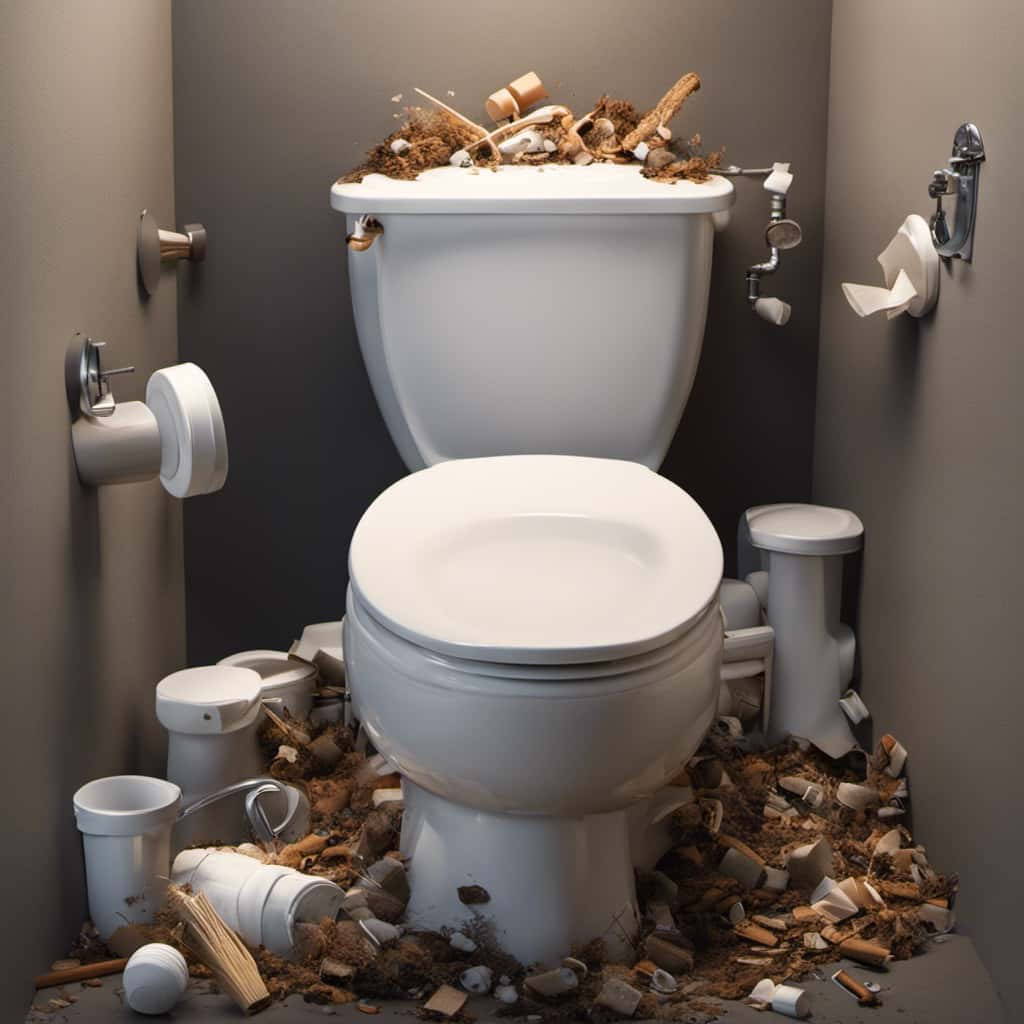
Slowly and evenly warm the pipe until the ice inside melts and water begins to flow freely.
It’s important to note that prevention is key to avoiding frozen toilet pipes. Insulating the pipes, keeping the toilet lid closed, and maintaining proper heat in the surrounding area are effective prevention methods.
Frequently Asked Questions
How Can I Prevent My Toilet Pipes From Freezing in the First Place?
To prevent toilet pipes from freezing, we recommend insulating them with toilet pipe insulation. Additionally, winterizing your plumbing system is crucial. This involves draining any excess water, sealing leaks, and keeping the temperature in your home above freezing.
Are There Any DIY Methods to Thaw Frozen Toilet Pipes Without Calling a Plumber?
We can use various DIY methods and thawing techniques to unfreeze toilet pipes without calling a plumber. These techniques can be effective in restoring the flow of water and preventing further damage to the pipes.
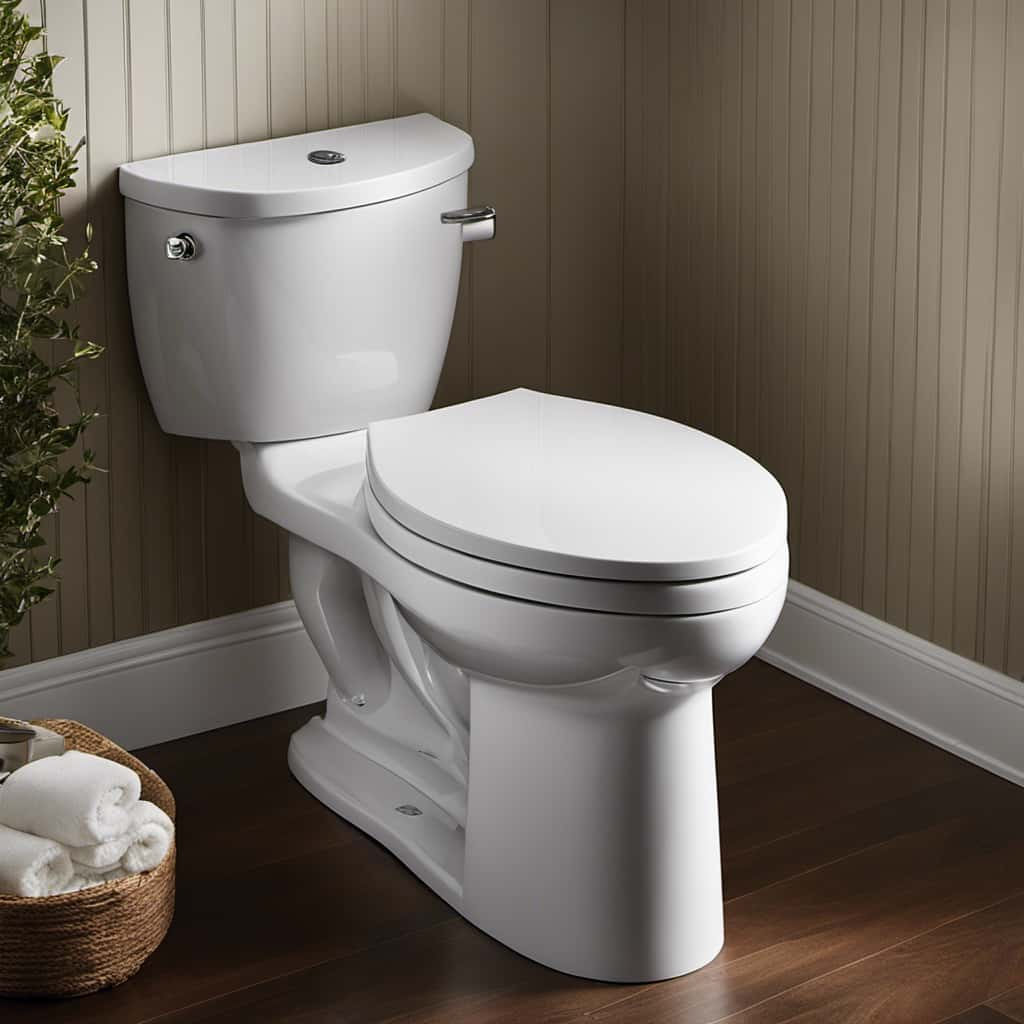
Can Frozen Toilet Pipes Cause Damage to Other Plumbing Fixtures in My House?
Frozen toilet pipes can potentially cause damage to other plumbing fixtures and the structural integrity of the house. Common mistakes to avoid when dealing with frozen toilet pipes include using excessive heat and attempting to thaw them with sharp objects.
Are There Any Specific Signs or Symptoms That Indicate the Severity of Frozen Toilet Pipes?
There are clear signs that indicate the severity of frozen toilet pipes. These signs include lack of water flow, strange noises, and visible frost on the pipes. Proper diagnosis is crucial for timely repairs.
Is It Safe to Use a Hairdryer or Heat Gun to Thaw Frozen Toilet Pipes?
Using a hairdryer or heat gun to thaw frozen toilet pipes is not recommended as it can cause damage and increase the risk of fire. There are alternative methods to thaw pipes without calling a plumber.
Conclusion
In conclusion, identifying frozen toilet pipes can be done by observing common symptoms such as reduced water flow, strange noises, and odors. Physical signs like frost or ice formation on the pipes also indicate freezing.
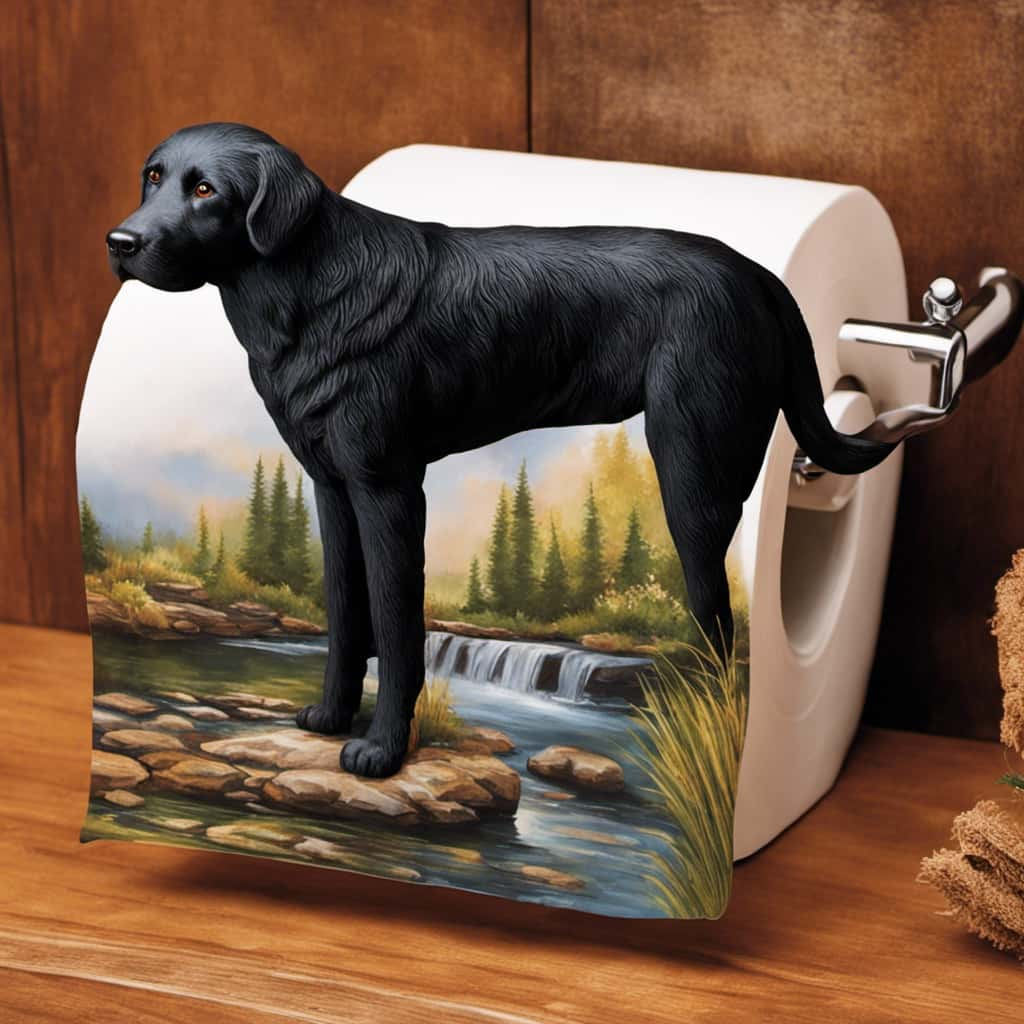
To address this issue, it’s essential to thaw the frozen pipes using appropriate steps. Remember, ‘an ounce of prevention is worth a pound of cure,’ so taking necessary precautions during cold weather can help avoid the inconvenience and potential damage caused by frozen toilet pipes.







